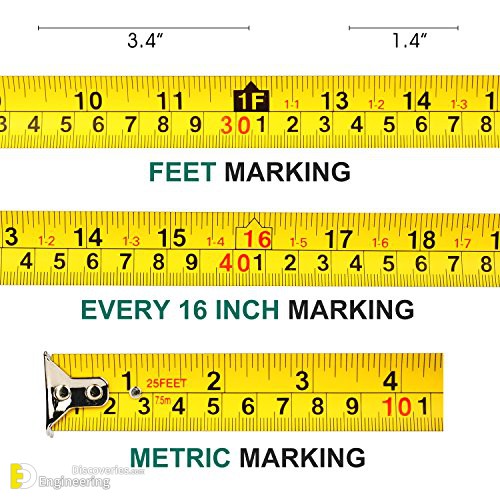

Using a Tape Measure to Measure Lengths is an important part of learning how to read a tape measure. It is important to note that the larger lines will always represent a whole number of centimeters, while the small lines will represent fractions of a centimeter. For example, the measurement is three centimeters if there are three small lines between two larger lines. The number of small lines that appear between the two larger lines will represent the number of centimeters that are being measured. To measure in centimeters, count the number of small lines between the two more extensive lines. Each of these small lines represents a single centimeter. Look for the small lines between the larger bars to read centimeters on a tape measure. Reading Centimeters on a Tape Measure is an important skill when measuring lengths. For example, if the tape measure reads 1/2, 3/4, the size is 1 3/4 inches. To measure a longer distance, count the number of inch marks and add the fractional part of the measurement for each inch mark. For example, if the tape measure reads 1/2, then the measurement is 1 1/2 inches. To read the measurement, count the number of inch marks and add the fractional part of the measurement. These are the fractions of an inch, such as 1/2, 1/4, or 1/8. Look for the more minor markings between the inch marks.Look for the longest marking, which will be the inch mark.These will be marked with fractions, such as 1/2, 1/4, or 1/8. Start by looking for the inch markings on the tape measure.Reading Inches on a Tape Measure is an important skill to master when learning to read a tape measure. Knowing the different measurement units and their equivalents is essential for understanding how to read a tape measure. A centimeter is equal to 0.3937 inches, and a meter is equal to 100 centimeters. Metric sizes are expressed in centimeters and meters. Measurements are expressed in miles to measure more considerable distances, equal to 5,280 feet. A foot equals 12 inches, and a yard is similar to 3 feet. An inch is the smallest unit of measurement and is equal to 1/12 of a foot. In the United States, measurements are typically expressed in inches, feet, and yards. Understanding measurement units is important to learn how to read a tape measure.
Tape measure reading all sizes pro#
With this guide, you can use a tape measure like a pro in no time. This article on How to Measure will provide a comprehensive guide to understanding and using a tape measure, from understanding the different measurement units to measuring angles and estimating measurements. These stud designations are intended to indicate the "on-center" position of framing members.Reading a tape measure can be tricky to master, but with the proper knowledge and practice, anyone can become an expert. You will rarely use these markings unless you happen to be building a shed or playhouse, or constructing partition walls during major remodeling projects. These increments correspond to the common intervals for the studs, joists, and rafters that are used to create the basic structural framework for walls, floors, and roofs. Find the Stud Markingsįor the benefit of framing carpenters who do repetitive work, most tape measures also have convenient markings at 16-inch and 19.2-inch increments, usually designated by a number highlighted in red, or by a small diamond marking on the blade. 1/16- and 1/32-inch increments are more often used in fine woodworking projects where hardwood workpieces need to fit very tightly. When framing walls, for example, tolerances down to 1/8-inch are usually completely sufficient to bang studs and joists into place. On dual-purpose tape measures, the numerals on the opposite side of the blade indicate centimeters.įor general construction work using framing lumber, it's usually sufficient to measure down to 1/8-inch increments.On some tape measures, the inch markings repeat 1- to 12-inch increments on one side of the blade, with running inch increments on the other side (as shown here).Inch marks are usually in the largest font.At 8 feet, for example, you will see both a "8 ft." and a "96" inch designation. Inch mark numbering usually continues along the entire length of the blade. The next increments of measure on a tape measure blade are the inch marks, which will be identified by the longest lines and usually labeled with a single numeral-1, 2, 3, etc. It's the same thing, but a little easier to read on the tape and remember. So, instead of a ceiling being measured as 7 feet, 6 inches, it would be measured as 90 inches. That way, you only need to pay attention to one set of figures: inches. The Spruce Home Improvement Review Boardįoot marks are valuable, but often it's easier to avoid them altogether and measure only in terms of inches.


 0 kommentar(er)
0 kommentar(er)
